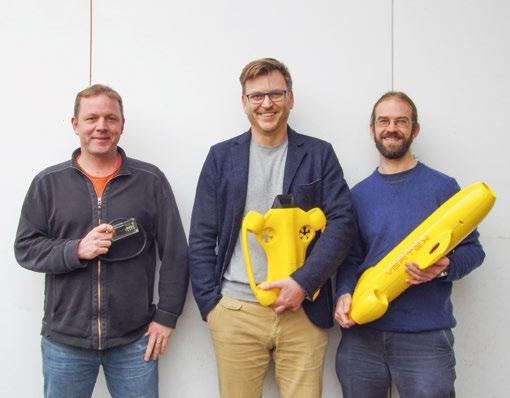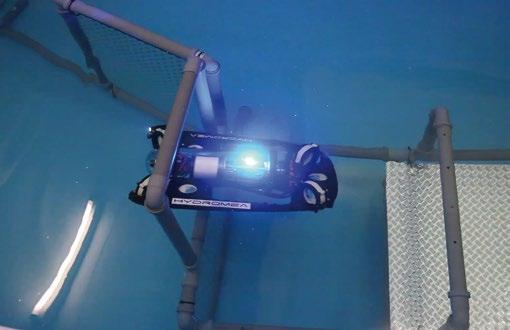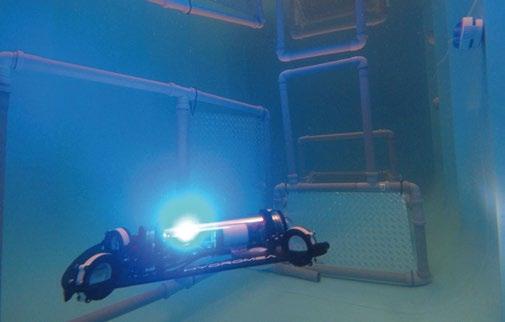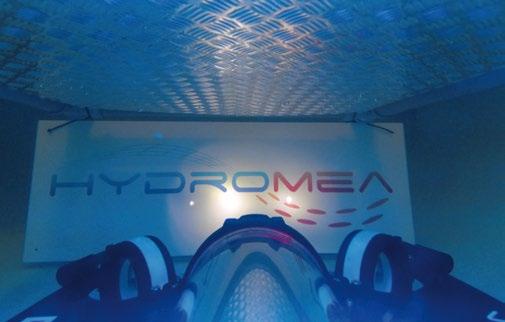
6 minute read
ExRay: The World’s First Wireless Portable Underwater Drone
Courtesy of Hydromea
EXRAY
Advertisement
Hydromea unveiled the prototype of the world’s first wireless underwater drone in a pool demo this month. The drone can fit into a backpack, can be remotely controlled, and sends HD video back in real time, without any physical connection to the pilot. The drone will deliver significant benefits in several inspection scenarios in confined flooded spaces, such as hydropower dams, closed waterways, and ballast tanks on ships. This will reduce cost and time and eliminate the safety risks posed by dangerous inspections currently performed by humans.
MEET THE HYDROMEA TEAM
Founded in 2014, Hydromea is a Swiss-based autonomous underwater robotics company, delivering solutions that allow customers to have unparalleled access to subsea data and underwater assets. Ultra-fast and high-volume real-time data transfer and harvesting have brought a paradigm shift in our quest to explore the ocean and understand its impact on the subsea economy. The Hydromea team started this journey in Australia over 15 years ago, where they put together their first portable underwater drone, Serafina. Years later they found a home in Lausanne, Switzerland, the hub of fine manufacturing. Having a passion for ocean exploration and exploring how big data is changing the world around us, they quickly realised that there is still a significant gap in our understanding of the oceans. Hydromea develops products and solutions


Courtesy of Hydromea Courtesy of Hydromea


Courtesy of Hydromea

that allow customers to have autonomous high-speed and high-volume subsea data access in real-time. This new technology renders cables obsolete, making previous prohibitively expensive projects affordable, and keeping humans away from risky jobs by combining autonomous robotics and wireless communication network systems. This presents a a drastic improvement in affordability and speed of subsea data access. Importantly, it also reduces human risks to zero.
The core team at Hydromea consists of Igor Martin, CEO, who has over 15 years of corporate business management experience in DuPont. He works alongside Felix Schill, CTO, who is an expert in real-time systems, ad-hoc communication networks, aerial and underwater robotics, as well as designing and building electronics, embedded systems, rapid manufacturing/3D printing, composite manufacturing, and mechanical design. And finally, Alexander Bahr, COO, who is an expert in the cooperation and navigation of large groups of AUVs, and has hands-on experience with the design, testing, and deployment of underwater sensing equipment.
THE EXRAY™ VISION
The initial focus of the technology is on the complex confined spaces where tether management is particularly difficult. With EXRAY™, asset operators will be able to replace manned entry for inspections of such spaces, saving time and cost on the preparation of such entry: no need for draining, drying, and ventilating, or for scaffolding. Hydromea is funded by Aberdeen-based OGTC with the support of Total E&P UK. The trials of the system on Total’s FPSOs in the North Sea are planned for later this year.
Courtesy of Hydromea
Once the dexterity of the system is de-risked in the confined spaces, Hydromea will take on the inspection and monitoring tasks in the harsh realities of the open water. The inspection and monitoring of industrial underwater structures today is labour and equipment intensive. It is performed by ROVs or divers, with the heavy involvement of offshore support vessels and helicopters. The inspection requirements will continue to increase as new oil and gas platforms are built and many legacy platforms will be decommissioned.
Additionally, the exponentially growing number of offshore wind farms and their adjacent infrastructures will further drive the need for a constantly available method to inspect both them and their impact on the environment. Operators incur substantial costs to maintain assets and verify compliance with regulations, and environmentally induced delays in infrastructure inspections cause loss of production revenue.
Remote operations which don’t require surface vessel support, or complex power and data umbilical cable systems to offshore platforms or land, have the potential to offer tremendous savings over operations that would otherwise require manned vessels. This includes long-term environmental monitoring, frequent subsea equipment integrity inspections, and interaction with seafloor assets and sensors. As a result, complex AUVs are being developed by many established players in the industry, that cost less to own and operate than the large surface vessels but are still relatively expensive and hard to maintain devices.


Courtesy of Hydromea Courtesy of Hydromea


Courtesy of Hydromea

Hydromea takes a complimentary but unique approach to the future of asset integrity, with its expertise in compact, affordable, and robust underwater systems. Hydromea focuses on a scalable, small, autonomous underwater drone platform with swarm intelligence: tightly integrated with the autonomous subsea infrastructure of tomorrow. It will offer efficiency and marked affordability in routine inspection and monitoring operations and facilitate a timely response to ad hoc events like extreme weather or subsea equipment failure. Many of the challenges associated with the inspection of offshore oil and gas operations can be addressed by deploying compact, multi-vehicle, subsea inspection and monitoring systems, with fast data collection and communication capabilities.

IMPROVING ON THE CURRENT MODEL
The benefits of affordable swarm deployments include additional capabilities, such as: conducting cost-effective, short-term or ad-hoc environmental monitoring to establish and track conditions before, during, and after exploration through production. Delivering frequent, cost-effective inspections for cable infrastructure, risers, chains, and equipment integrity. Responding quickly to out-of-cycle inspection requirements. And pairing with seafloor sensors and monitoring equipment for quick data uploads and near real-time transfer to the control centre.
This represents a shift in the type of operations being performed offshore, and the need for specialist, agile systems to perform tasks that current market WROV’s have struggled to do. They also represent issues that the larger
Courtesy of Hydromea
AUV’s currently being developed will not easily address, such as ultra-shallow water operations. Furthermore, employing large and expensive vehicles for light and short duration inspection tasks isn’t cost effective today, nor will it likely be tomorrow. The emergence of compact, intelligent, and robust underwater drones will fill that niche, and Hydromea are one of the pioneers in this regard.
Hydromea plan to continue developing a platform that will introduce a suite of purpose-specific, low-footprint, underwater drones for various inspection scenarios. They will focus on adding autonomy features over time to eventually make this a fully autonomous swarm system for inspection and monitoring of submerged assets, at an affordable price tag and with smart intelligence built in.
So far, Hydromea have performed 11 open water campaigns with their initial drones known as Vertex, even performing one under an ice sheet. They were able to collect water quality data in continuous flow over a prescribed perimeter. This allowed them to build a 3D map each time, and help researchers understand the actual situation in the environment, without the need for post-collection modelling.
EXRAY™ recycles a lot of technology that went into the Vertex system. However, EXRAY™ is currently focused on confined spaces, and they haven’t yet performed any industrial trials. Total is supporting them with this effort, and they will soon start running trials on Total’s North Sea assets. We’re very eager to report on EXRAY™’s progress in the near future.

